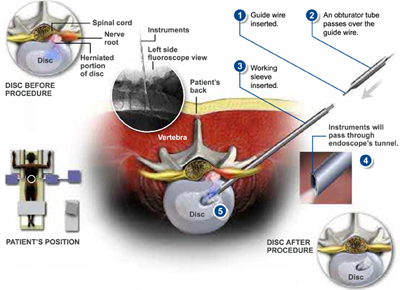 What is the YESS Selective Endoscopic Discectomy Procedure?
What is the YESS Selective Endoscopic Discectomy Procedure?
1. Guide Wire Inserted
After the disc protrusion is confirmed, a guide wire is inserted to the affected disc. The surgeon uses a special type of x-ray machine called a fluoroscope to ensure that the route to the herniated disc is made in the correct location.
2. Obturator Inserted
A two-hole obturator tube is passed over the guide wire to push apart the tissue down to the disc and to move the nerve root out of the way. Painful tissue in the path of the obturator may be anesthetized.
3. Working Sleeve Inserted
The working sleeve, through which the surgery will be performed, is slid over the dilating tube. It is positioned on the disc surface. The guide wire and dialator are then removed.
4. Endoscope Inserted
An endoscope (which contains a surgical light and small camera) is placed through the tube, allowing the surgeon to view the annulus, disc, and epidural space on a video monitor. The surgeon will use the endoscope to guide the surgical tools and inspect the results.
5. Degenerative Portions Removed
The surgeon uses instruments to remove degenerative and extruded portions of the disc nucleus. Because only enough of the disc is removed to reduce pressure inside the disc, the spine remains stable.
Disc Wall Treated
The disc wall defect is treated with a laser and radiofrequency probe. The foramen and nerves are inspected to confirm successful decompression. The instruments and sleeve are removed.
End of Procedure
The insertion area in the skin is covered with a small bandage. The patient may need a day of bed rest after the procedure and physical therapy. Most patients may return to normal activity within one to six weeks.